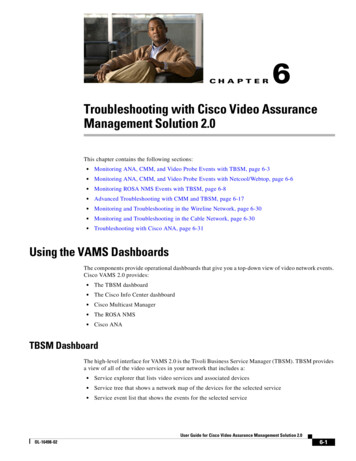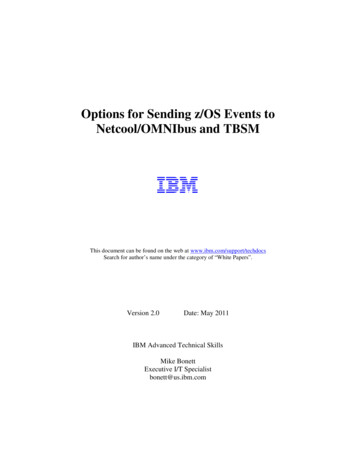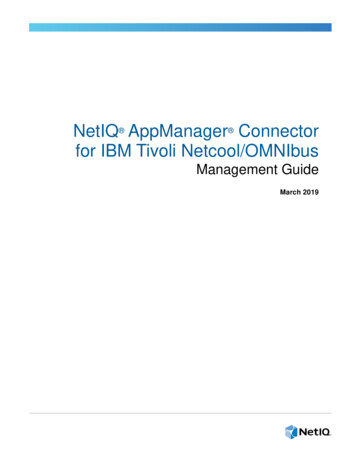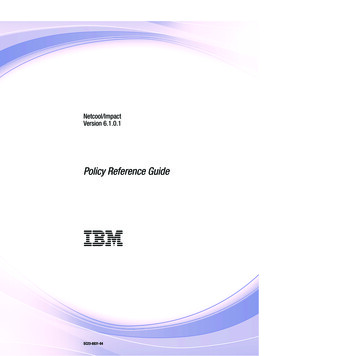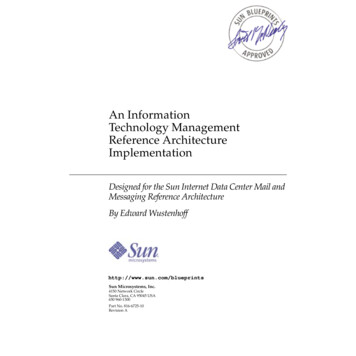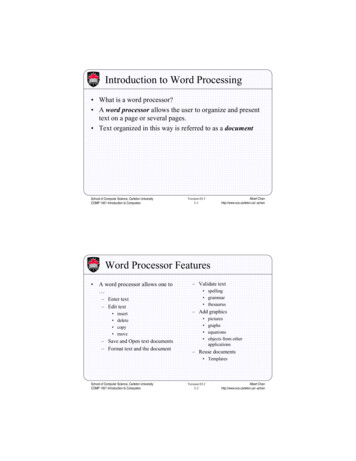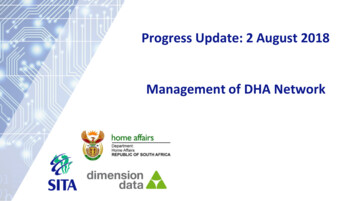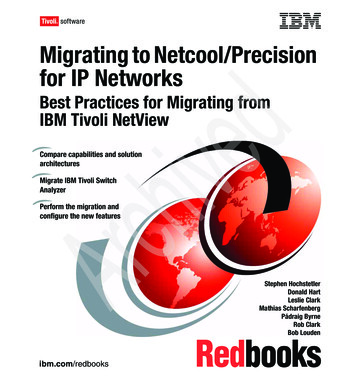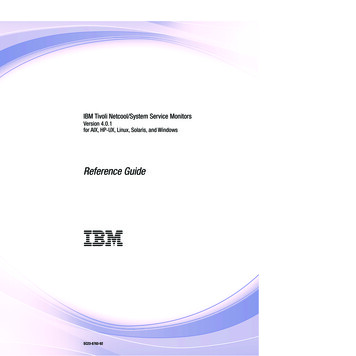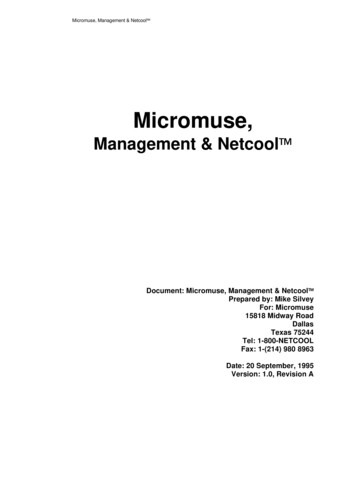
Transcription
Micromuse, Management & Netcool Micromuse,Management & Netcool Document: Micromuse, Management & Netcool Prepared by: Mike SilveyFor: Micromuse15818 Midway RoadDallasTexas 75244Tel: 1-800-NETCOOLFax: 1-(214) 980 8963Date: 20 September, 1995Version: 1.0, Revision A
Micromuse, Management & Netcool 1995 Micromuse PLC, Micromuse USA, Inc.Micromuse Standard DisclaimerIn no event will Micromuse PLC be liable for any lost revenue profit or data, or for special,indirect, consequential, incidental or punitive damages however caused and regardless oftheory of liability arising out of the use or inability to use the system, even if Micromuse hasbeen advised of the possibility of such damages. In no event shall Micromuse's liability tocustomer, whether in contract, tort (including negligence), or otherwise, exceed the feecharged by Micromuse for the implemented solution.Copyright 1995 Micromuse PLC, Micromuse USA, Inc.2
Micromuse, Management & Netcool 1995 Micromuse PLC, Micromuse USA, Inc.1. Micromuse, Management & Netcool 1.1 IntroductionThis guide has been developed as an aide to both sales, technical support staff, andprospective customers to provide a better understanding of Micromuse, and the Netcool range of products, the market segment they address and operate in, some of thecompetitive products, and where we intend to go with the Netcool range, and ComplexityManagement.The guide can be used standalone, or in conjunction with the Netcool productpresentations. The guide may contain information which will be of interest to organizationswith competitive products so should be treated as Company sensitive. If there isinformation in the guide that you think may be useful as a sales tool forcustomers/prospects, this can be reviewed and made available by the MicromuseNetcool team.Sales guides are only useful if they are readable, concise, up to date, and contain relevantinformation. If you have any comments on the information in this guide, please discussthem with either Christopher Dawes, Mike Silvey, or Colin Pittham.3
Micromuse, Management & Netcool 1995 Micromuse PLC, Micromuse USA, Inc.2. Contents1. Micromuse, Management & Netcool . 31.1 Introduction .32. Contents . 43. Micromuse. 63.1 A Brief History .63.2 Company Profile. 74. Complexity Management . 84.1 Enterprise Management.84.1.1 The International Standards Organisation . 84.1.1.1 Open Systems Interconnect (OSI) Connectivity 7 Layer Model . 84.1.1.1.1 .94.1.1.2 OSI Network Management Categories. 94.1.1.2.1 Fault Management .94.1.1.2.2 Performance Management . 94.1.1.2.3 Accounting Management . 104.1.1.2.4 Configuration Management. 104.1.1.2.5 Security Management. 104.1.2 Operational Enterprise Management Solutions .104.2 Micromuse’s Complexity Management Architecture.124.2.1 The Tactical Complexity Management Architecture.124.2.1.1 The Agents.134.2.1.2 Management Platform .134.2.1.3 Performance Baselining.144.2.1.4 Fault Filtering .144.2.1.5 Service Level Management/ServiceDesk .144.2.2 The Strategic Complexity Management Architecture.155. Other Management Concepts. 175.1 Inclusive Management .175.2 Exclusive Management .185.3 The Benefits of Exclusive Management .185.4 Service Level Management.195.4.1 An Illustration of Service Level Management.195.5 Virtual Private Networks (VPNs).215.6 Applied VPNs with Service Level Management .225.7 The Role of the Telco in Managed Network Services .226. Netcool ? . 244
Micromuse, Management & Netcool 1995 Micromuse PLC, Micromuse USA, Inc.6.1 The Netcool Product Family .246.1.1 History.246.2 Netcool /OMNIbus .246.2.1 What is Netcool /OMNIbus?.246.2.1.1 A Detailed Explanation .256.2.1.2 Netcool /OMNIbus and the Remedy Action Request System .276.2.2 Example Implementation Profiles for Netcool /OMNIbus.296.2.2.1 Single Management Platform.306.2.2.2 Multiple Management Platforms.316.2.2.3 Remote Facilities Monitoring.326.2.2.4 Wide Area Monitoring .326.3 Netcool /LegacyWatch .346.3.1 What is Netcool /LegacyWatch .346.4 Netcool /Messenger .376.4.1 What is Netcool /Messenger? .377. Case Studies . 387.1 A High Street Financial Organisation Monitoring Burglar Alarm Systems .407.2 A Telecomms Carrier Monitoring Its Data Network Infrastructure .387.3 A Telecomms Company Providing Customer Network Management.418. Competition and Other Noise. 438.1 History of the MoM .438.2 MAXM Systems, Inc. MAXM .448.2.1 Overview .448.2.2 Technical Description .448.2.3 Competitive Profile .458.2.4 MAXM in Summary.468.2.5 MAXM Pricing.468.3 Boole and Babbage, Inc. Command/Post .468.4 Objective Systems Integrators, Inc. OSI-NetExpert .478.5 Competitive Feature Breakdown Matrix .495
Micromuse, Management & Netcool 1995 Micromuse PLC, Micromuse USA, Inc.3. Micromuse3.1 A Brief HistoryMicromuse was formed in September 1989, by Christopher Dawes, as a Unix SystemsIntegrator to Corporate environments.In 1989, Unix was quite unknown (and almost taboo) in environments other than FinancialDealing Rooms and Universities, so Micromuse was at the leading edge in delivering Unixto Corporate operations.The Company quickly became respected for its technical skills, which were normallyemployed in integrating the Unix systems with legacy, or PC systems, where previouslyintegration had been poor.With the growth in demand for Unix in Corporate environments, came a growth in thecomplexity of the environments the systems were operating in. Issues includedconnectivity, network management and systems management and administration.Gradually, more of the Company’s time was spent solving complex networking andmanagement problems, that Micromuse decided to focus on the area of NetworkManagement.In 1992, Micromuse launched Complexity Management and instantly became a leader inNetwork Management integration. The Complexity Management architecture wasinnovative and simple.Complexity Management was founded on the principle that since open systems basednetworks change on a six monthly cycle, any network management environment must becapable of rapid reconfiguration and flexibility. Bespoke applications just cannot do the job.Also, Micromuse was tracking developments of the SNMP based management platforms(SunNet Manager & HP OpenView Network Node Manager), and the wealth of compatiblepartner applications which were being introduced to provide network analysis, troubleticketing, systems performance monitoring, device configuration and other functionality.Micromuse’s Complexity Management architecture defined the requirements of amanagement environment, then chose the best of breed component products which bestdelivered that functionality.Qualifications for inclusion in the Complexity Management architecture were that theproducts were best of breed, configurable with little effort, and could integrate with eachother. Development is not the key, strategically, identification of products and thesubsequent integration of those products into a Complexity Management system is theissue.Over the years, Complexity Management has been proved as a working architecture fornetwork management integration - delivering functionality which was not available inmonolithic products, or non-integrated Complexity Management components.6
Micromuse, Management & Netcool 1995 Micromuse PLC, Micromuse USA, Inc.By 1993, Micromuse identified that an emerging requirement from telecomms companiesand corporate organisations was for Service Level Management - the real timemaintenance of Service Level Agreements SLAs) on Virtual Private Networks (VPNs).Micromuse embarked on the development of the Netcool range of products, withNetcool /OMNIbus as the flagship Service Level Management system.Netcool /OMNIbus was designed to deliver Service Level Management, with informationfrom any SNMP or other Management Platforms and devices to map onto prescribedService Level Agreements.Netcool /OMNIbus as a monitor of managers is covered later in this paper, but differsfrom other offerings in that the product is an application, not a development environment.Netcool /OMNIbus was launched at the Enterprise Management Summit’94 in SantaClara, CA, at release 1.0. Release 2.0 general availability was January 1995, andNetcool /OMNIbus version 3.0 is released on 30th September, 1995.Micromuse now delivers its Complexity Management and Service Level Managementsolutions to Fortune 500 Corporations in the US, Europe and Scandinavia, and is lookingto grow an Asian operation, in the future.3.2 Company ProfileMicromuse, was established in 1989, and is the leading developer and integrator ofService Level Management products specifically for telephony & corporate environments.The company has offices in the US and Europe, providing both support andsales/marketing activities.The personnel profile of Micromuse is split; 50% technical support, 25% sales andmarketing, and 25% finance and operations. Currently, there are 60 employees(September, 1995).Micromuse's Netcool range of products provide Service Level Management to enterprisenetwork environments.The Netcool range of products have won awards for innovation in network management,such as Data Communications “Hot Product” and Managing Distributed Systems“Application Excellence” awards.Since inception, the company has grown 50-100% year on year, with a gradual transitionof major revenues from hardware to network management software, with the turnover forFY’95 being around 20M.Revenues from Service Level Management and Helpdesk products for Financial Year 1995will make up 50% of turnover.7
Micromuse, Management & Netcool 1995 Micromuse PLC, Micromuse USA, Inc.4. Complexity ManagementComplexity Management is an architecture for the delivery of network managementsolutions to Enterprise Management problems.Enterprise Management is the all encompassing management of an organisation’s IT andtelephony environments. Micromuse has coined the phrase Complexity Management todescribe our approach to solving the problems of Enterprise Management.Micromuse’s Complexity Management solution, which can be a combination of manyproducts including the Netcool branded products, will address specific key solutions ofEnterprise Management problems.4.1 Enterprise ManagementEnterprise Management problems can be divided into a number of categories, dependingon the authority discussing the problem. In this document we will discuss two approaches,that of the International Standards Organisation’s Open Systems Interconnect ISO OSIManagement Framework, and that of the operational environment, where a realorganisation has to deliver a management solution to it’s varied requirements.4.1.1 The International Standards OrganisationThe International Standards organisation (ISO) is a group representing the interests ofcompanies with a charter to provide standards (for amongst other things) computercommunications and management interfaces.ISO has members from all the leading telecomms companies, and other computing andcorporate organisations with a large investment in diverse computing and communicationstechnologies.The charter is to deliver published interoperable standards that any organisation can workwith freely, and if the organisation is a fully paid up member of the ISO, can contribute tothe standards proposals.4.1.2 Open Systems Interconnect (OSI) Connectivity 7 Layer ModelThe International Standards Organisation (ISO) has for several years been deliveringstandard interface APIs for the Information Technology industry to enable different types ofelectronic devices (computers, telephony equipment, Coke machines, etc.) tocommunicate with each other. These standards are called Open Systems Interconnect(OSI).OSI defines many areas of computer systems interaction, using a seven layer model todefine the various layers of interconnectivity with various API interfaces describingconnectivity at each layer. The following diagram illustrates the layer definitions.8
Micromuse, Management & Netcool 1995 Micromuse PLC, Micromuse USA, DatalinkPhysicalWith the ISO OSI Seven Layer model, computer communications protocols have beendefined to allow transparent communications and application interaction betweenheterogeneous varieties of computer system and networks (i.e. IBM mainframes and Unixsystems).Now that the communications standards have been defined, the ISO set about producing aset of standards for computer system network management - sometimes referred to asOSI Network Management, or CMIP/CMISE - although CMIP/CMISE are some of theactual protocol definitions for OSI Network Management, not the architecture.The ISO first defined five categories of network management, and the next sectiondescribes OSI Network Management and the five management categories.4.1.3 OSI Network Management CategoriesOSI Network Management has been broken down into five distinct categories that the ISObelieves encompasses all aspects of network management environments, for any givenpiece of computer equipment.4.1.3.1 Fault ManagementThe Fault Management category defines all aspects of handling a fault, such as what is afault and the types of faults you can have. This includes for our purposes, aspects ofhelpdesk/trouble-ticketing, fault correlation and consolidation.4.1.3.2 Performance ManagementPerformance Management defines the long term monitoring of a managed object or groupof managed objects. If you monitor something for a long enough period, you can establisha performance baseline that represents how the object works under differentcircumstances.The more objects you monitor concurrently, the better a composite view of your networkyou will have, and so the better you will be able to react to circumstances because you willhave seen those conditions before.9
Micromuse, Management & Netcool 1995 Micromuse PLC, Micromuse USA, Inc.4.1.3.3 Accounting ManagementAccounting Management is all about being able to use the Fault and PerformanceManagement data to account for aspects of usage of equipment. It is not just used forbilling purposes - for instance you may wish to account for the certain usage of a line tocost justify increasing the bandwidth, the same applies to the usage of a large server withrespect to upgrading it. Without the accounting data, this is not really possible (only fingersin the air can help!).4.1.3.4 Configuration ManagementConfiguration Management is fairly simple to understand. It defines how you interact withan object to control it, and how you maintain previous configurations, etc. ConfigurationManagement is all about the administration of objects.4.1.3.5 Security ManagementThe Security Management category defines all aspects of interaction between managedobjects and management tools, such as access security authentication, encryption of dataduring conversations, etc.4.1.4 Operational Enterprise Management SolutionsIt’s all very well having interoperability and management standards defined by an industrybody such as the ISO, but sometimes, because of the complexity of the task of creatingthe standards, the time it takes, and the pace of change in the computing industry, thesestandards do not get widely adopted, or, something different comes along which takes themarket by storm.This has happened in the network management arena. The ISO OSI NetworkManagement standards have been very slow to develop. Much of the work has been putinto infrastructure as one might expect, which has meant that the detail of interoperabilityof the OSI management standards has come much later.Also, much of the OSI Network Management work has gone into defining standards for thetelecomms players, who are actually delivering a very complex service and need tointeroperate with each other.Because the OSI Network Management standards have been aimed at the telecommsplayers, the standards defined are very complex to implement, and so widespread marketadoption of them has not happened.The general market outside of the telecomms companies have chosen to implementnetwork management environments using an Internet defined management protocol calledthe Simple Network Management Protocol (SNMP).This has led to a divergence of management platforms (the application that users use),some for specific managed objects using either OSI Network Management protocols orproprietary, and the so called open management platforms used to manage SNMPnetworks.10
Micromuse, Management & Netcool 1995 Micromuse PLC, Micromuse USA, Inc.Also, although the ISO OSI framework for management (the five categories) seems todefine what a network management system should deliver, there is no single productwhich can provide every requirement.In fact those applications which have tried to do everything have ended up being less thangood in any area.Since there is no single application which provides a complete network managementsystem, integrated network management environments have to be created usingcomponent based applications.Component applications are those which deliver a useful function of a networkmanagement environment, and can integrate with other applications to provide a networkmanagement solution.Working operational network management environments will only be delivered byimplementing a solution using many different management applications, all providing acertain function, that when integrated co-operatively delivers an integrated networkmanagement solution.11
Micromuse, Management & Netcool 1995 Micromuse PLC, Micromuse USA, Inc.4.2 Micromuse’s Complexity Management ArchitectureFor the past 5 years Micromuse have been integrating "open" management solutions,utilising best of breed, off the shelf components integrated from the ComplexityManagement architecture.Micromuse defined both the term, Complexity Management and the block diagramarchitecture to enable us to present the “What we do” and position the managementapplications in our portfolio.The Customer/prospect has confidence that the Micromuse Complexity Managementsolution can deliver tactical point management solutions, that later can be integrated withother products (from the architecture) developed from a “tactical” management solutioninto an enterprise management system.Complexity Management makes it easier to implement management, by breaking down theenterprise into deliverable components that can be integrated later. In addition, the initialoutlay of money can also be reduced, and thus easier to justify.The Complexity Management architecture shows that Micromuse actually understands theproblems that IT management staff and operators face, and can address those problems,without having to buy the whole system at once.The added benefit to the customer is that Micromuse uses best of breed, industryacclaimed products (some of which we actually helped make into the names they are now)integrated together to provide the whole solution.Its interesting but today, there are many imitators of the Micromuse ComplexityManagement architecture - such as AT&T GIS with their OneVision program - althoughOnVision has some fundamental architecture misfits.4.2.1 The Tactical Complexity Management ArchitectureMicromuse has defined the Complexity Management architecture to be independent of anyparticular network management platform. Although in reality, with the products in ourportfolio from US vendors, the main management platforms to work with will be those fromSun, Hewlett-Packard, and IBM, since most of the products were designed to work withthese.The Complexity Management architecture defines a number of interconnected blocks (orcategories) which allow us to deliver much functionality described by the five OSI NetworkManagement categories.12
Micromuse, Management & Netcool Configuration etControlPlatformAgents 1995 Micromuse PLC, Micromuse USA, Inc.Service ment PlatformPhys.NetConn.BlocksSystemAppsThe Tactical Complexity Management ArchitectureWe have chosen the best of breed products for each category, making sure that differentapplications in the categories can talk to each other in a logical way which allows anintegrated network management system to be developed. Into each block of theComplexity Management Architecture, our customers can either put their favourite product,or use one of our "best of breed" choices.4.2.1.1 The AgentsAt the base of the architecture we have the agents - categorised into the PHYSICALNETWORK; mainly RMON LAN and WAN probes, CONNECTIVITY BLOCKS; meaningthe blocks that connect networks together - routers, Hubs, bridges, switches, etc.,SYSTEMS; agents which provide for the management of operating systems such asSunOS, Solaris, AIX, Windows NT and Novell, etc., and APPLICATIONS; applying todatabases, and other applications which need managing (i.e. Reuters Triarch).At the Physical Network agent level, Micromuse provides Frontier NETscout and HPNetMetrix, no agents are provided by Micromuse for the Connectivity Blocks because mostof them today are equipped with SNMP agents. At the Systems level, Micromuse suppliesLandmark Systems TMON for Unix, and IBM’s Systems Monitor (for use with NetView forAIX under certain circumstances), and at the applications level Micromuse currentlysupplies BMC Patrol (although there are several SNMP agents on the market for Databasemanagement).4.2.1.2 Management PlatformNext block is the MANAGEMENT PLATFORM. In most cases we are normally referring toSunNet Manager, HP-OpenView Network Node Manager, or IBM NetView for AIX (andSolaris).Equally apply this category to your favourite network management platform (CabletronSPECTRUM, Network Managers, NetLabs, SMS, Novell/NMS, etc. [forgive me if I missone out!]).Generally we would recommend only using the platform as a hub for gathering networkfault and performance information from the managed objects, since most of the platforms13
Micromuse, Management & Netcool 1995 Micromuse PLC, Micromuse USA, Inc.on the market are both not truly multi-user (with authentication etc.) or, support faultcorrelation.and in addition, they do not integrate well with other like/unlike managementplatforms (but of course they all promise this in the future!!!).Micromuse supplies SunNet Manager, Sun Solstice Enterprise Manager, HP OpenViewNetwork Node Manager (NNM), and IBM NetView for AIX.4.2.1.3 Performance BaseliningAt the next layer, we are looking at tools to enhance the (lacking) functionality of themanagement platforms. Firstly, network managers should be addressing PRE-EMPTIVEmanagement, not just PRO-ACTIVE management, i.e. identifying that the problem is goingto happen before it actually happens, not after(!). To do this you need goodPERFORMANCE BASELINING of your managed environment to both profile theperformance of the internetworked elements, and to identify the "whys?" of breakdowns ofparts of the network environment. In other words, see what failed when, and what othercomponents may have caused the "what" to fail, and then, identify the prevailing conditionswhich led to the failure of that item.allowingthe organisation to set up some FAULT FILTERING.Micromuse has historically sold Remedy’s Health Profiler into this category, althoughrecently this product was discontinued. We still discuss this category, although we are atpresent without a product.4.2.1.4 Fault FilteringThe popular management platforms don't do FAULT FILTERING too well (some would say"not at all!"). Most administrators have spent an awful long time setting up theirmanagement platform for both Trap handling, and Event polling for specific conditions then unfortunately meet with the problem that there is no Event de-duplication (i.e. a faultcondition generates multiple notifications or traps), or Event/Trap Correlation (i.e. the abilityautomate: if this and that happen at this time, alert me).Micromuse provides Netcool /OMNIbus to do this.4.2.1.5 Service Level Management/ServiceDeskAbove these tools comes both SERVICE LEVEL MANAGEMENT, and SERVICEDESK.The two are very separate and extremely compatible, and almost self requiring of eachother. The Service desk is used by the back end support teams for management of thefault process/escalation etc., and the Service Level Management element is used by thesupport teams for real-time monitoring of Service Le
Netcool /OMNIbus as a monitor of managers is covered later in this paper, but differs from other offerings in that the product is an application, not a development environment. Netcool /OMNIbus was launched at the Enterprise Management Summit'94 in Santa Clara, CA, at release 1.0. Release 2.0 general availability was January 1995, and
